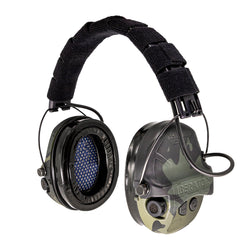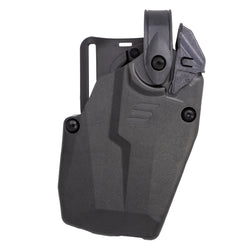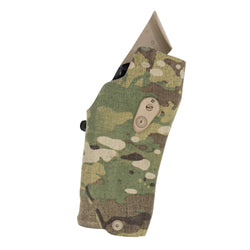One of the most misunderstood concepts in firearms training is the 21-Foot Rule, a legacy of the Tueller Drill. Somehow, a mere seven yards, just 21 feet, became a supposed fixed tactical and legal boundary. Its mythos spread through online forums, gun-store gossip, and range talk.
Let’s be clear: there is no 21-foot rule. The entire concept of the Tueller Drill is a dangerous oversimplification of a critical training concept that has led to poor tactics and flawed legal justifications. To understand the actual lesson, we need to revisit the original 1983 experiment by Sgt. Dennis Tueller and reevaluate the “rule” that was never actually established.
The History of the Tueller Drill
Sgt. Dennis Tueller of the Salt Lake City Police Department published an article in the March 1983 issue of SWAT Magazine based on a series of experiments he had conducted. Tueller wanted to know how close was too close when it came to engaging a threat armed with a melee weapon of some sort.
Tueller seems like the enterprising type because instead of asking others, he decided to conduct his own experiment to find out. His goal was to see how fast someone could cover seven yards and attack a target with a melee weapon.

He used seven yards as the standard distance because that was what the SLC cops were training at. Tueller timed how long it took for a number of volunteers to cover those seven yards and attack the target, and came up with a time of 1.5 seconds.
Tueller then timed how long it took to draw and fire two accurate shots from his duty revolver. In an interesting twist of fate, it took about 1.5 seconds. Tueller published his results in an article that is still insightful and worth reading now, over four decades later.
How did this become such a misunderstood mythos? I can’t necessarily answer the ‘how’ politely, but I can address the ‘what’ in terms of misconceptions that arose from Tueller’s experiment.
The Misconceptions
A Legal Standard
One of the more common myths you’ll hear when anyone mentions Tueller or the 21-foot rule is that the experiment established some form of legal precedent. Essentially, if your attacker is armed with a melee weapon and is more than 21 feet away, you cannot engage them.
This is simply false. A magazine article does not establish legal precedent. The use of deadly force is judged based on the totality of the circumstances and the defender’s reasonable belief of an imminent threat of death or serious bodily harm to themselves or an innocent person, not on a pre-determined distance.

21 Feet Separates Winners and Losers
A tactical myth about the Tueller drill states that if the bad guy is greater than 21 feet away, you’ll win. It’s not even a contest; the bad guy couldn’t possibly cover 22 feet before you could draw and shoot. It’s true that distance is your friend, and more is better, but it doesn’t guarantee a win.
Additionally, if you’re 20 feet from an attacker with a knife, it doesn’t mean you’ll automatically lose. Tueller’s experiment was based on the average of his participants. If he were facing an NFL receiver or sprinter, the time is going to be different.

If I were chasing him, the time would be a bit different as well because I’m not built for speed and rapid acceleration. However, I can draw and shoot two shots in less than 1.5 seconds, and so can a lot of other people, so you gotta be quicker than the average these days.
Standing Still and Firing Twice
If you were to believe in the 21-foot rule and that it’s the end-all be-all to close-quarters combat, you have to make two assumptions. First, if you’re being attacked, you have to stand still. Second, it will only take two shots to stop a threat.

That’s not reflective of reality. In the real world, you can move, and Tueller encouraged police to move. That’s become a standard for dealing with threats: Get off the X, get off the line, etc.
In the real world, handguns suck at fighting. You might have to fire way more than two rounds, or you might only have to fire one. Handguns require you to hit the vitals to stop a threat; you’ll have to fire as many shots as necessary to stop the attack.
The Truth About The Tueller Drill
The Tueller Drill wasn’t intended to establish a rule, tactical or legal, regarding defensive shooting. The goal was to highlight a concept known as the reactionary gap and to illustrate its existence to police officers, as well as how to expand their understanding of it.

The Tueller drill is designed to surprise officers by showing that even 21 feet isn’t a safe distance. The drill showed that when an attack is sudden, the average officer could only tie with the attacker. You might shoot the bad guy, but he’s going to stab you.
Tueller highlighted that action gives you an advantage over reaction. The action gave the attackers a clear and distinct advantage, forcing the officer to react. If you have to react, you want as much time as possible, and time means space. Tueller preached using distance as a tool to avoid attacks.

Additionally, the goal of the Tueller Drill was to show the advantage of movement. The movement could be a tactical retreat where the officer retreated, but drew his weapon to engage. Additionally, he preached lateral movement, getting off the line, and putting cover between you and the attacker.
Movement resets the reactionary gap. When a cop reacts and moves, this forces the attacker to react. Therefore, the reactionary gap has been expanded.

Tueller also preached the benefits of enhanced situational awareness. He wanted officers to recognize danger earlier, which gave them more time to react, and once again, expanded the reactionary gap.
Ditch the Myth
There is no 21-foot rule, and Tueller wasn’t trying to create any kind of rule, tactically or legally. He was attempting to illustrate a concept and to educate officers on the reactionary gap and how to increase it. The work still stands to this day. If there is one thing to remember, it’s this: action beats reaction and distance equals time.









